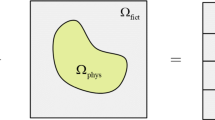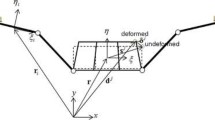Abstract
Multi-flexible-body dynamics (MFBD) and the discrete element method (DEM) are well suited for co-simulation. This paper proposes an efficient, robust, and stable strategy for co-simulating between MFBD solvers and DEM solvers based on the conventional serial staggered (CSS) procedure for co-simulation. A standardized version of this strategy is also proposed that enables the DEM solver to be embedded into the MFBD software. If embedded in this manner, the MFBD software could be extended to create a single MFBD/DEM model, execute a co-simulation, and post process the results in one environment. The proposed strategy is coded into the commercial software RecurDyn. A simple DEM solver is formulated in this paper, embedded into RecurDyn, and numerical examples to demonstrate the feasibility of this proposal are presented.
Similar content being viewed by others
References
A. A. Shabana, Dynamics of Multibody Systems, Cambridge University Press (2005).
O. A. Bauchau, Flexible Multibody Dynamics, Springer Science and Business Media, 176 (2010).
O. C. Zienkiewicz, R. L. Taylor and J. Z. Zhu, The Finite Element Method: Its Basis and Fundamentals, Elsevier (2005).
T. Belytschko, B. Moran and W. K. Liu, Nonlinear Finite Element Analysis for Continua and Structures, Wiley, 1 (1999).
A. A. Shabana, Computational Continuum Mechanics, Cambridge University Press (2008).
FunctionBay, RecurDyn Solver Theoretical Manual, Function-Bay, Inc. (2020).
J. Choi, H. S. Ryu and J. H. Choi, Multi flexible body dynamics using incremental finite element formulation, ECCOMAS Thematic Conference Multibody Dynamics, Warsaw (2009).
J. Choi, A study on the analysis of rigid and flexible body dynamics with contact, Ph.D. Dissertation, Seoul National University, Seoul, Korea (2009).
M. A. Crisfield and G. F. Moita, A unified co-rotational framework for solids, shells and beams, International Journal of Solids and Structures, 33(20–22) (1996) 2969–2992.
G. Sanborn, J. Choi, J. S. Yoon and J. H. Choi, Systematic integration of finite element methods into multibody dynamics considering hyperelasticity and plasticity, Journal of Computational and Nonlinear Dynamics, 9(4) (2014) 041012.
J. S. Yoon, J. S. Park, C. O. Ahn and J. H. Choi, Cosimulation of MBD (multi body dynamics) and DEM of many spheres using GPU technology, Particles II: Proceedings of the II International Conference on Particle-based Methods: Fundamentals and Applications, Centre Internacional de Mètodes Numèrics a l’Enginyeria, Barcelona (2011).
D. Negrut, D. Melanz, H. Mazhar, D. Lamb, P. Jayakumar and M. Letherwood, Investigating through simulation the mobility of light tracked vehicles operating on discrete granular terrain, SAE International Journal of Passenger Cars-Mechanical Systems, 6(2013-01-1191) (2013) 369–381.
A. Recuero, R. Serban, B. Peterson, H. Sugiyama, P. Jayakumar and D. Negrut, A high-fidelity approach for vehicle mobility simulation: nonlinear finite element tires operating on granular material, Journal of Terramechanics, 72 (2017) 39–54.
S. Lommen, G. Lodewijks and D. L. Schott, Co-simulation framework of discrete element method and multibody dynamics models, Engineering Computations, 35(3) (2018) 1481–1499.
P. A. Cundall and O. D. L. Strack, A discrete numerical model for granular assemblies, Geotechnique, 29(1) (1979) 47–65.
J. Ghaboussi and R. Barbosa, Three-dimensional discrete element method for granular materials, International Journal for Numerical and Analytical Methods, Geomechanics, 14(7) (1990) 451–472.
D. A. Horner, J. F. Peters and A. Carrillo, Large scale discrete element modeling of vehicle-soil interaction, Journal of Engineering Mechanics, 127(10) (2001) 1027–1032.
H. Nakashima and A. Oida, Algorithm and implementation of soil-tire contact analysis code based on dynamic FE-DE method, Journal of Terramechanics, 41(2–3) (2004) 127–137.
C. Farhat, M. Lesoinne and P. Le Tallec, Load and motion transfer algorithms for fluid/structure interaction problems with non-matching discrete interfaces: momentum and energy conservation, optimal discretization and application to aeroelasticity, Computer Methods in Applied Mechanics and Engineering, 157(1–2) (1998) 95–114.
S. Piperno and C. Farhat, Partitioned procedures for the transient solution of coupled aeroelastic problems, part II: energy transfer analysis and three-dimensional applications, Computer Methods in Applied Mechanics and Engineering, 190(24–25) (2001) 3147–3170.
J. Niiranen, Fast and accurate symmetric Euler algorithm for electromechanical simulations, Electrimacs 99 (Modelling and Simulation of Electric Machines Converters and Systems) (1999) 1–71.
J. C. Simo and L. Vu-Quoc, On the dynamics in space of rods undergoing large motions-a geometrically exact approach, Computer Methods in Applied Mechanics and Engineering, 66(2) (1988) 125–161.
K. J. Bathe, Finite Element Procedures, Prentice Hall, Pearson Education, Inc. (2006).
O. L. Jay and D. Negrut, A second order extension of the generalized-α method for constrained systems in mechanics, Multibody Dynamics, Springer, Dordrecht (2009) 143–158.
M. Michael, A discrete approach to describe the kinematics between snow and a tire tread, Doctoral Dissertation, University of Luxembourg, Luxembourg (2014).
M. Michael, F. Vogel and B. Peters, DEM-FEM coupling simulations of the interactions between a tire tread and granular terrain, Computer Methods in Applied Mechanics and Engineering, 289 (2015) 227–248.
K. Shoemake, Animating rotation with quaternion curves, Proceedings of the 12th Annual Cnference on Computer Gaphics and Interactive Techniques (1985) 245–254.
E. B. Dam, M. Koch and M. Lillholm, Quaternions, Interpolation and Animation, Datalogisk Institut, Københavns Universitet, 2 (1998).
V. L. Popov, Contact Mechanics and Friction, Springer Berlin, Heidelberg (2010) 231–253.
Y. Tsuji, T. Tanaka and T. Ishida, Lagrangian numerical simulation of plug flow of cohesionless particles in a horizontal pipe, Powder Technology, 71(3) (1992) 239–250.
J. J. Monaghan, Smoothed particle hydrodynamics, Reports on Progress in Physics, 68(8) (2005) 1703.
S. Koshizuka and Y. Oka, Moving-particle semi-implicit method for fragmentation of incompressible fluid, Nuclear Science and Engineering, 123(3) (1996) 421–434.
R. Nelson and M. G. Olsson, The pendulum-rich physics from a simple system, American Journal of Physics, 54(2) (1987) 112–121.
Acknowledgements
This research is supported by the 2018–2019 KyungHee University Research Support Program.
Author information
Authors and Affiliations
Corresponding author
Additional information
Graham Sanborn received his Ph.D. in Mechanical Engineering from the University of Illinois at Chicago in 2009. He is a Senior Research Engineer at FunctionBay, Inc.
Juhwan Choi received his M.S. and Ph.D. degrees in School of Mechanical and Aerospace Engineering from Seoul National University, Korea in 2000 and 2009, respectively. He is currently a Head of R&D center and Chief Technical Officer at FunctionBay, Inc.
** Hwan Choi received his M.S. and Ph.D. degrees in Mechanical Engineering from University of Illinois at Chicago in 1992 and 1996, respectively. He is currently a Professor of KyungHee University of Mechanical Engineering.
Rights and permissions
About this article
Cite this article
Sanborn, G., Choi, J. & Choi, J.H. Strategy for co-simulation of multi-flexible-body dynamics and the discrete element method. J Mech Sci Technol 35, 4363–4380 (2021). https://doi.org/10.1007/s12206-021-0908-2
Received:
Revised:
Accepted:
Published:
Issue Date:
DOI: https://doi.org/10.1007/s12206-021-0908-2




